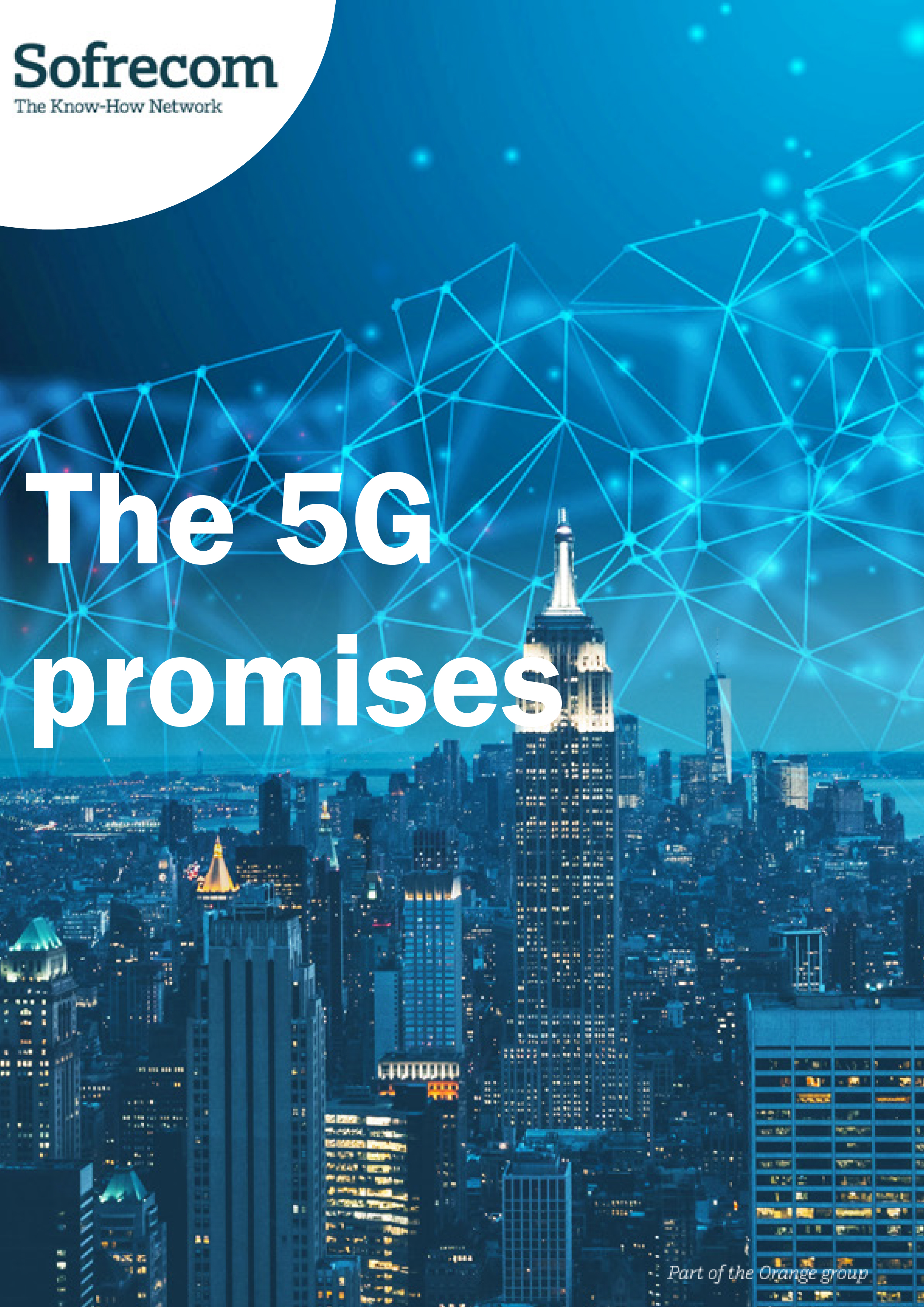
The arrival of 5G opens many opportunities for the wholesale operator. It can diversify its offers and integrate IT services in particular.
Clément Roulleau

With many European countries announcing the arrival of 5G in 2020, the question as to what benefits it will actually bring is dividing sector experts. The consumer market appears skeptical as to whether the foreseeable benefits are worth the extra price. On the corporate market, a number of uses on business verticals are said to be prospective revenue streams. As to wholesale operators, they wonder about the offers they will be able to market in 5G and about the potential for capturing value on this new market. We offer an overview of what makes 5G distinctive and the benefits which each market segment can expect from it.
The B2C market, awaiting figures that tell of decisive gains
Although in 2019, consumer awareness of 5G grew across the countries that had launched the technology, including the US and the UK, few 4G users appear willing to spend more to receive the benefit of 5G services. Is this due to a lack of understanding, or are the benefits of 5G not quite enticing enough? Let’s run through the features specific to 5G to understand where its commercial potential lies.
A real increase in speed - but not quite high enough to shift the tide
5G is being touted as enabling a massive increase in throughput. The theoretical flow ratethroughput will increase by a factor of 10, offering performance levels comparable to those of fiber.
The first tangible benefit of 5G thus supposedly lies in the potential to use the mobile network as an alternative to the fiber network. Even though this had already been partially accomplished with 4G, 5G could thus bring rural areas super-fast broadband similar to fiber in speed and reliability. This would benefit both the consumer and the operator, as well as cut their FTTH connection costs, which are generally high for isolated households.
According to Ericsson, average consumption per user will increase from an average of 6Gb per month to 24Gb by 2025, supported mainly by video. The question nonetheless remains: is there a real chance that greater speed alone will fuel such a surge in consumption? If the changeover from 3G to 4G put a smooth viewing experience within everyone’s reach, what are the advantages 5G can use to carve out its own space? While an attractive selling point on paper, the ability to view videos in 4K or potentially 8K will only marginally improve the user experience. This is because, while screens are growing larger, mobile devices are not designed for resolutions of that kind. It is thus not easy to convince users.
Then comes the ability to download, via the 5G network, very large videos and/or files usually transferred to the fixed network. This would considerably facilitate downloads on mobile. The benefit is real, but must be communicated on as such, with offers specifically tailored to data volume needs.
Latency: the benefits are real, but need more explanation
The second key benefit of 5G lies in its latency, divided by ten. It would thus theoretically drop from 10 ms to 1 ms. Despite these enthusing figures, though, the B2C market is still having trouble detailing and understanding how this improvement will actually bring added value.
The reduced latency will have a crucial impact on the streaming market. It will be the central building block around which the streaming platforms of the future will be built and, more broadly, all streaming-related innovations that incorporate interaction.
Beyond streaming, gaming will also enjoy significantly greater flexibility, as with 5G, developers will be able to host their games in the cloud. The games will thus be operated partly remotely and displayed in real time, with a minimum response time. As a result, users will be able to play anywhere, on their usual mobile or tablet device.
For the Virtual Reality and Augmented Reality market, latency will offer similar benefits. However, when it comes to the use cases and the terminals using these technologies on the move for B2C, many details remain to be filled in.
Greater network reliability to enable continuous performance
Although little has been communicated regarding the B2C market, the benefit of “guaranteed service” is the one that could make the greatest mark on consumers.
Looking beyond throughput and latency, then, 5G will greatly improve the reliability of mobile connections. It is believed that consumers will be able to sense the difference in everyday use.
The B2B market will benefit from all the features that make 5G different
None of the uses specific to 5G for the B2B segment have yet been designed. Although they have been described in broad lines (the connected car, industry 4.0, etc.), their development remains in its infancy. Nevertheless, one thing is already certain: operators must continue to invest. Above all, they must collaborate and create partnerships with industry players to refine their use cases and develop end-user services that take maximal advantage of 5G while remaining closely in step with manufacturers’ needs.
Here, we will focus on the two main benefits of the mobile network's move upmarket: terminal density and latency.
“Massive IoT” as the driving force behind the cities of tomorrow
The term “massive IoT” refers to the multitudes of sensors and devices that will be in communication with one another through 5G. The new IMT-2020 standard associated with 5G requires a minimum connection density of 1 million devices per km² (as compared to 60,680 for 4G)
It is indeed “massive IOT” that will enable the Smart City concept to fulfill its potential: resource and operation management in large cities will not be viable unless automated. It relies on data captured via this swarm of sensors.
However, there will also need to be guarantees on the reliability of the underlying connectivity, thanks to high data throughput and low latency that enable rapid and real-time transfer of information.
Latency fitted to the key issues at stake for “critical IoT”
On the existing mobile networks, the average latency is neither reliable nor regular enough to be applied to critical industrial control systems. It could do costly damage and, in worst-case scenarios, cause accidents. The alternative offered by wire is expensive and impractical.
5G, in contrast, is perfectly suited to the task.
The most widely discussed use case is that of the self-driving car. While it does not require massive data speed, the autonomous vehicle does rely on real-time communication with other vehicles, the road infrastructure (road sensors, lights, bad weather, etc.) and the network that connects them all up. At stake is the safety of passengers. The self-driving car will not reach the mass market until there is a mobile network that meets the latency criteria promised by 5G.
Maintenance and emergency services will also be able to enjoy optimized efficiency thanks to this technology. For instance, a worker equipped with a virtual reality headset will be able to benefit from expert advice or control machines remotely, almost in real time.
The same benefits will be available in the health sector, where it will become possible to carry out medical procedures remotely.
New opportunities on the wholesale market
As for wholesale operators, the arrival of 5G gives them many opportunities to diversify their offers, in particular by incorporating IT services into them.
First of all, they will be able to market access to miniaturized 5G smart antennas, known as small cells -- or even manage the said small cells. This is because the millimetric frequencies (in 26 GHz) involved imply a very low range, and thus require a very fine mesh of “small cells” across the territory.
Secondly, the virtualization of the 5G network, with network slicing, will provide it with previously impossible flexibility in the way network infrastructures and connectivity are managed and marketed. This feature will enable operators to divide their infrastructure into virtual network slices, and provide each customer with a turnkey network tailored, via Cloud properties, to its specific capacity, latency and reliability needs.
It clearly addresses the two problems currently emerging for companies:
- a growing need for services based on the Cloud, edge computing, CDNs, and platforms;
- the expectation that there will be strong integration between connectivity and IT services, securing end-to-end performance in their industrial facilities.
New customer types could emerge. For instance, an electricity supplier having decided to operate its own meter reading network could turn to a wholesaler to rent just the amount of 5G connectivity it needs, that segment ultimately becoming a slice of the network.
While feasibility and potential revenue levels are still uncertain, the opportunities offered by this transformation of the network are clear, and will need to be planned for by wholesale operators.
In conclusion:
5G is being described as a major improvement to the very high-speed mobile network. However, this improvement will be felt differently from segment to segment: while the increase in throughput, terminal density and decrease in latency seem to be the perfect fit for the B2B market, these same benefits do not appear to hold the same potential for innovation in B2C. As to wholesale operators, they will enjoy significantly greater flexibility in the way they manage and market their network infrastructures and connectivity, thanks to the network virtualization enabled by 5G in SA mode.
It is now up to the operators to find, in particular by continuing to iterate on use cases via solid partnerships with players in each ecosystem, the right business models to turn these opportunities into offers in step with the needs of each segment.





